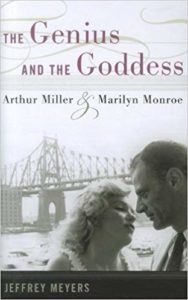
The debate over Marilyn Monroe’s acting chops began the moment she hit the silver screen and continues to the present day. Some film critics and scholars consider her a great comedic actress; others think she was the original “dumb blonde.” Monroe was aware of the stereotype and hoped her third husband, Arthur Miller, would write a serious role for her. Though Jeffrey Meyers’s new biography, The Genius and the Goddess, purports to chronicle their unusual marriage, in actuality the book is an assault on Monroe’s personal life that stops just short of character assassination.
Relying heavily on the account of Elia Kazan, who was friends with Miller and bedded Monroe before he did, Meyers classifies Monroe as “a decent-hearted kid who Hollywood had brought down, legs parted.” In order for Monroe to get jobs, he tells us, she would frequently sexually service the studio heads. When she signs her first contract with Fox, he quotes Monroe as saying, “I have sucked my last cock.”
Going further into her sexual and medical history, Meyers writes, “When selling herself, or with romantic liaisons and long-time lovers, Marilyn, always eager to please, meekly agreed to men’s demands to have sex without contraceptives and got pregnant again and again.” Then comes “the horrifying confession” that she’d had twelve abortions. As disturbing as that number is, Monroe’s contraceptive options in 1951 were severely limited and, as an international sex symbol, she most likely had sex with more men than the average woman. In another passage, Meyers describes Monroe’s slovenliness: “But dirtiness, especially in a woman who spends most of the day beautifying herself, was a sure sign of mental illness. When depressed she even went out in public with menstrual stains on the back of her dress.” Later, he mentions that Monroe slept wearing a bra “to prevent her breasts from sagging.” Even setting aside the sexism that leads Meyers to harp on such details, they are obsessive and irrelevant and make no contribution to a reader’s understanding of this marriage.
Miller, in stark contrast, is characterized as a saint. “Many men had slept with Marilyn,” we are reminded, “both before and after she’d become a famous sex symbol, and thought nothing of abandoning her the following day, but Miller was devoted to her and always treated her with respect.” How does Meyers know that these men “thought nothing of abandoning her”? And why does he assume Monroe was interested in anything more—why couldn’t it have been she who did the abandoning? As for Miller, in the years post-Marilyn, he remarried and had a son, born mentally handicapped. Miller placed him “in a home for the mentally retarded. Inge [Miller’s wife] visited him weekly for forty years. Miller never did.” Here, though, Meyers makes no comment, though the abandonment of one’s child might say more about one’s character than, say, whether or not one sleeps with a bra on.
After reading The Genius and the Goddess, we know a great deal about Monroe’s sexual and hygienic habits, but very little about why Arthur Miller and Marilyn Monroe were married. And sadly, by the time we get to The Misfits, the script Miller wrote for Marilyn, their marriage is already over. Though much time has been spent on Monroe’s time in the orphanage as a child, her first marriage, her relationships with Joe DiMaggio and other men, by the end her relationship with Miller has barely been discussed. Meyers does devote the last chapter to Miller’s work inspired by Marilyn after her death—After the Fall, Mr. Peter’s Connections, and Finishing the Picture—labeling her “Miller’s Tragic Muse,” but his relationship to her while she was alive remains murky.
Monroe’s life has proven to be a source of endless fascination—and speculation—for biographers, and the experienced Meyers (he has written over forty books) is no exception. It’s obvious he conducted a vast amount of research, particularly when chasing down details on her numerous lovers and bad habits. Meyers mentions that Sylvia Plath considered Monroe “her fairy godmother,” because Plath related to her struggles with depression. The comparison between them is apt—both have become cultural icons, with tragic histories that have often been co-opted to comment on women’s issues. To reference Janet Malcolm’s excellent book on Sylvia Plath, they are “silent women”—in death, they have no voice, no protection from endless inquiry, distortion, exploitation. Arthur Miller met with Meyers to discuss The Genius and the Goddess (there is a photograph of them together on the book jacket), but this obviously was not possible for Marilyn Monroe. In her absence, as in Plath’s, those who write about her consult diaries, letters, gossip—and their imaginations. “Silent women” serve as a screen upon which they, and we, project whatever we want to believe.
There is no doubt that Marilyn Monroe was deeply troubled, as is clear from the details of her life and early death. She had little support, and no easy access to things that contemporary women take for granted: birth control, health care, and most importantly, feminism. Her letters to Miller’s son, with whom she kept in touch after their divorce, show her to have been sweet and loving. But you wouldn’t know that from most of Meyers’s biased, sexist account.




